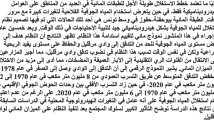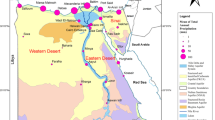Abstract
In the previous fifty years, there has been an astounding boom in agricultural groundwater use, improving livelihoods and food security (Giordano in Hydrogeol J 14(3): 310–318, 2006). Nevertheless, these remarkable improvements were not possible without a price to pay: agricultural groundwater use stands as a major threat to both quantity and quality of aquifers. This is particularly emblematic in semi-arid and arid regions where groundwater has always been an attractive solution for agriculture (Leduc et al. in Hydrogeol J 25(6): 1529–1547 2017). As a matter of fact, regions where agriculture strongly depend on groundwater uses such as the Mediterranean regions and Latin American countries are the most affected by aquifer overexploitation.
Access provided by CONRICYT-eBooks. Download conference paper PDF
Similar content being viewed by others
Keywords
1 Introduction
In the previous fifty years, there has been an astounding boom in agricultural groundwater use, improving livelihoods and food security (Giordano 2006). Nevertheless, these remarkable improvements were not possible without a price to pay: agricultural groundwater use stands as a major threat to both quantity and quality of aquifers. This is particularly emblematic in semi-arid and arid regions where groundwater has always been an attractive solution for agriculture (Leduc et al. 2017). As a matter of fact, regions where agriculture strongly depend on groundwater uses such as the Mediterranean regions and Latin American countries are the most affected by aquifer overexploitation (e.g. Garrido et al. 2005). For instance, a growing awareness of the groundwater as a critical natural resource leads to an urgent need to design a governance mechanism at both local and national levels (Faysse et al. 2011). However, the “silent revolution” of agricultural development carried out informally outside the scope of public policies (Fornés et al. 2005) has permanently created a wide gap between the pink-colored expectation of groundwater management strategies and the tough reality. In this context, a groundwater management strategy has been established to the Bouhefna-Haffouz aquifer in the upstream of the Merguellil basin in central Tunisia. The current study aimed to discuss the management strategy implemented for 50 years and based exclusively on hydrodynamic considerations while irrigation practices and technical progress drastically changed the individual groundwater form of access.
2 Materials and Methods
2.1 The Bouhefna-Haffouz Aquifer System Characteristics
In the upstream part of the Merguellil basin, the Bouhefna-Haffouz aquifer system is so far, the most vulnerable aquifer due to the intensive industrial and agricultural water use. The Haffouz aquifer corresponds to a collapsed basin filled with detrital sediments of miopliocene age. The Bouhefna aquifer is housed in a very diffusive sandstone filling of the upper Oligocene formation, it embodies an important hydrogeological potential. Naturally, the Bouhefna aquifer is confined; a part of its flow is discharged to the Merguellil wadi (and overflow springs) and another part to the Haffouz aquifer (Fig. 1). Since the 1970s, a groundwater management strategy called “the controlled overexploitation” was established to drop the water level in the Bouhefna aquifer to a target depth in order to minimize losses through evaporation (i.e. reduce flow to overflow springs and to Merguellil wadi). The main idea of this strategy follows the groundwater exploitation scheme proposed in Besbes (1967).
2.2 A Groundwater Model Set-up
A mathematical groundwater model was designed to investigate the difference between the expected impact of the groundwater management strategy and the actual situation of the aquifer system. The Modflow model has been used to achieve this work. A regular mesh over the modeled zone with square cells of 300-m sides has been used (a total of 2862 cells). A constant head condition was considered for the south-western limit of the oligocene layer (chosen far enough to minimize its influence) and for the northeastern limit of the Haffouz aquifer (feeding zone by Djebel Ousslet). To simulate drainage by the Merguellil Wadi and overflow springs, drain conditions were imposed. The Merguellil wadi bound also the southern limit of the model. Elsewhere, the model boundaries were considered as a no flow conditions. According to pumping tests (11 tests spatially homogeneous), the hydraulic conductivity has been initiated to a value ranging between 5 10−5 and 4 10−4 m/s for the Haffouz aquifer and between 10−3 and 10−4 m/s for the Bouhefna aquifer. The storage coefficients ranged between 3 10−4 and 1 10−3 for Bouhefna aquifer and between 5 10−2 and 10−1 for Haffouz aquifer. The recharge rate was estimated according to a relationship between total annual rainfall and effective annual rainfall (i.e. maximum recharge in the case of no runoff occurs). The calculation is based on a Thornthwaite method with monthly values using the estimated mean evapotranspiration values of the El Haouareb dam station with an RFU value of 50 mm. The total rainfall-effective rainfall relationship shows that the threshold beyond which a deep recharge occurs is about 200 mm and that 45% of the 720 years considered in the calculation are without recharge. The groundwater abstractions are carried out by various actors, notably the SONEDE,Footnote 1 which is the biggest operator of drinking water supply and the DGREFootnote 2 for rural water supply. Official records of groundwater withdrawal show that the aim of the groundwater strategy has been fulfilled i.e. groundwater abstraction has reached a maximum rate over the period between 1975–1985 (19 h m3 in 1980) and thereafter taken down to a rate equal to the renewable recharge (9 hm3). However, official records are highly uncertain and incorporate only a limited number of individual wells. Nevertheless, our field investigation shows that there are almost 40 deep wells only in the region of Khit El Oued. To overcome this lack of information we decided to calibrate the model over the period 1970–1980 where hydro-agricultural practices were less intense. Indeed, our investigation on archival documents allowed confirming that there are no deep well in the region over the period 1970–1980, almost all wells at that time were concentrated around rivers to capture underflow or springs. The model was firstly calibrated in steady state (1967), subsequently in transient over the period 1970–1980 and finally applied to the period 1980–2015.
3 Results and Discussion
For steady sate calibration 8 polygons of permeability were defined for the Haffouz aquifer ranging from 10−5 and 9 10−4 and 3 polygons for the Bouhefna aquifer with a permeability oscillating between 10−4 and 9 10−4 m/s. The overall accuracy of the simulation was between 0.5 and 3 m compared to the observed values, giving a determination coefficient of 90%. However, the overall quality of the model is penalized by the absence of observation points in the southern part of the Bouhefna aquifer and the reconstitution i.e. in this part the calibration is closely related to the boundaries conditions. In the transient state calibration (period 1970–1980), the storage coefficients were calibrated. For the Bouhefna aquifer, the coefficient of determination is greater than 65% and the RMSE is less than 1.2 m for all the points showing a good restitution of the observed piezometric levels (storage coefficient ranged between 3 10−3 and 7 10−3). For the Haffouz aquifer, the coefficient of determination oscillates between 0.5 and 0.7 and the RMSE between 0.2 and 2 m (storage coefficient between 10−2 and 5 10−2). The sensitivity tests show that the horizontal permeability of the Haffouz aquifer and the conductivity of the Merguellil wadi are, by far, the most sensitive parameters, a variation of ± 50% induces an increase of the RMSE from 15% to 22%. The second most sensitive parameter is the recharge; a variation of ± 50% of the calibrated value brings the RMSE from 7% to 11%. The rest of the parameters are less sensitive (RMSE between 4% and 6%). The application of the model over the period post-1980 shows, in accordance with what was expected, that the first part of piezometric chronicles over the period 1980–1985 was well reproduced by the model, whereas from 1985 onwards the calculated levels acquired a stabilization which was not observed in measured water level (Fig. 2). A reduction of groundwater inputs is difficult to defend here so the most probable explanation is that some additional outputs occurred at one point. The official pumping rates might be incorrect or additional individual groundwater withdrawals occurred. The withdrawal rate has to be multiplied by 1.7 over the period 1985–2006 and by 2.2 over the period 2006–2015 to reproduce the observed piezometric decline. The result suggests that the annual volumes of pumped water for irrigation are comparable to the official pumping by the public operator. The more intensive exploitation of the Bouhefna aquifer due to the intervention of unexpected new actors led also to the reduction of surface water availability by reducing the baseflow to the wadi and converted even more farmers to groundwater use.
4 Conclusion
The global change is progressively exerting pressures on hydrological processes and consequently on water resources. The dynamics can be relatively slow, often predictable or even voluntary, but some others can be insidious because unexpected. The case of the Bouhefna-Haffouz system showed that the water management strategy of the groundwater resource was well hydrodynamically designed and responded to the needs and social context at its own time. But the lack of adaptation to the rapid evolution of the hydro-agricultural practices led to a severe overexploitation with serious consequences on water resource availability. According to the modelling, individual pumping mobilizes almost the same amount of water as the public operator. This illustrates again the need to consider social aspects for sustainable water management strategies.
Notes
- 1.
National Water Supply and Distribution Company.
- 2.
General Directorate for Water Resources.
References
Besbes M. Contribution à l’étude hydrogéologique de la nappe de Haffouz. Ph.D. Thesis. Paris, France: Université de Paris IV; 1967.
Faysse N, Hartani T, Frija A, Tazekrit I, Zairi C, Chalouf A. Agricultural use of groundwater and management initiatives in the Maghreb: challenges and opportunities for sustainable aquifer exploitation. AFDB Economic Brief; 2011. p. 1–24.
Fornés JM, la Hera A, Llamas MR. The silent revolution in groundwater intensive use and its influence in Spain. Water Policy. 2005;7(3):253–68.
Garrido A, Martiınez-Santos P, Llama MR. Groundwater irrigation and its implications for water policy in semi-arid countries: the Spanish experience. Hydrogeol J. 2005;14:340–9.
Giordano M. Agricultural groundwater use and rural livelihoods in sub-Saharan Africa: A first-cut assessment. Hydrogeol J. 2006;14(3):310–8.
Leduc C, Pulido-Bosch A, Remini B. Anthropization of groundwater resources in the Mediterranean region: processes and challenges. Hydrogeol J. 2017;25(6):1529–47.
Author information
Authors and Affiliations
Corresponding author
Editor information
Editors and Affiliations
Rights and permissions
Copyright information
© 2018 Springer International Publishing AG
About this paper
Cite this paper
Jerbi, H., Massuel, S., Leduc, C., Riaux, J., Tarhouni, J. (2018). To What Extent Can Groundwater Uses Affect Long Term Sustainable Exploitation Schemes? Case Study of the Bouhefna-Haffouz Aquifer System (Central Tunisia). In: Kallel, A., Ksibi, M., Ben Dhia, H., Khélifi, N. (eds) Recent Advances in Environmental Science from the Euro-Mediterranean and Surrounding Regions. EMCEI 2017. Advances in Science, Technology & Innovation. Springer, Cham. https://doi.org/10.1007/978-3-319-70548-4_270
Download citation
DOI: https://doi.org/10.1007/978-3-319-70548-4_270
Publisher Name: Springer, Cham
Print ISBN: 978-3-319-70547-7
Online ISBN: 978-3-319-70548-4
eBook Packages: Earth and Environmental ScienceEarth and Environmental Science (R0)






